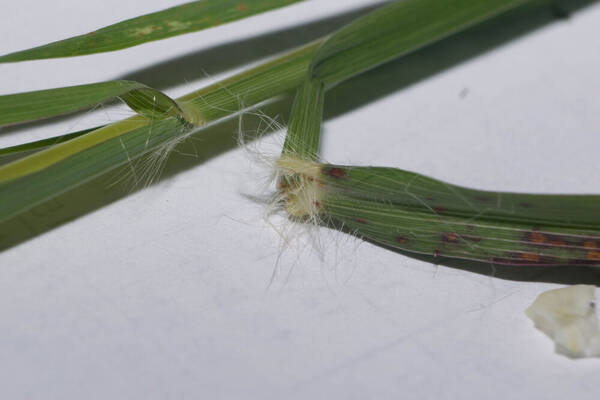Info
Subfamily: Panicoideae
Genus etymology: Bothriochloa = "pitted grass" [Greek] refering to the pits on the lower glume in most species
Species etymology: bladhii = honorific for Peter Johan Bladh 1746-1866
Photosynthetic type: C4 (warm season)
Nativity: naturalized - accidental
First recorded in Hawaiʻi: 1916
Map


Inflorescence




Habit


Spikelets









Node

Collar

Description
Tufted perennial; culms 50–150 cm. high, erect from a shortly rhizomatous base, often robust. Leaf-blades 10–55 cm. long, 2–12 mm. wide. Inflorescence with a central axis 4–20 cm. long, the racemes numerous and borne loosely or densely in irregular whorls upon simple or branched peduncles; racemes 2–5 cm. long (the lowest shorter than the central axis), pubescent. Sessile spikelet narrowly elliptic, 3–4 mm. long; lower glume chartaceous, ± hairy below the middle, usually not glossy, with or without a pit; awn 10–25 mm. long. Pedicelled spikelet glabrous, with 0–3 pits.
(Description source: Clayton, W.D. & Renvoize, S.A. 1982. Flora of Tropical East Africa. Gramineae (Part 3). A.A. Balkema, Rotterdam. 448 pp. )
Caespitose perennial of variable habit; culms up to 100 cm high, rather straggling, the nodes glabrous, the internodes terete or channelled on one side; leaf sheaths barbate at the base; ligule membranous; leaf laminas up to 30 cm × 10 mm, almost glabrous, tapering gradually to a slender apex. Inflorescence paniculate, with numerous slender branches 2–5 cm long on a common axis 3–10 cm long; lowermost branches sometimes themselves branched; spikelets usually dark purple or flushed with purple; rhachis internodes and pedicels pilose with hairs up to 2.5 mm long. Sessile spikelet 3–4 mm long, barbate at the base; inferior glume pilose below the middle on the back, rarely glabrous, rigidly ciliate on the margins above, depressed along the middle, with a deep or shallow pit in the upper part, the pit sometimes absent in some spikelets, rarely absent altogether; superior glume lanceolate, the margins sparsely ciliate above or glabrous, depressed along both sides of the keel, the keel scabrid above; inferior floret empty, the lemma oblong, obtuse, glabrous; superior floret epaleate, with stipitiform lemma; awn 10–18 mm long, geniculate, glabrous; anthers c. 1.5 mm long. Pedicelled spikelet usually smaller than the sessile spikelet and reduced to 1 or 2 glumes, rarely well developed and with the inferior glume pitted.
(Description source: Cope, T.A. (ed.). 2002. Flora Zambesiaca. Volume 10. Part 4. Kew, London. 190 pp. )
Culms 40-90(150) cm, usually erect; nodes glabrous or short hispid, with mostly appressed, less than 2 mm hairs. Leaves cauline; ligules 0.5-1.5 mm; blades (10)20-35(40) cm long, 1-4.5(5.5) mm wide, mostly glabrous. Panicles 5-15(24) cm, elliptic to lanceolate, reddish at maturity; rachises 6-12(20) cm, with numerous branches; branches 3-7 cm, shorter than the rachises, erect to spreading during anthesis, with axillary pulvini, lower branches with multiple rames; rame internodes with darkened grooves, with sparse, about 1 mm marginal hairs. Sessile spikelets 3.5-4 mm, oblong-ovate; lower glumes glabrous or scabrous, with or without a dorsal pit; awns 10-17 mm, twisted, geniculate; anthers 1-2 mm. Pedicellate spikelets about the same size and shape as the sessile spikelets, or about 1/2 their size, staminate or sterile. 2n = 40, 60, 80.
(Description source: Barkworth, M.E., Capels, K.M., Long, S. & Piep, M.B. (eds.) 2003. Flora of North America, north of Mexico. Volume 25. Magnoliophyta: Commelinidae (in part): Poaceae, Part 2. Oxford University Press, New York. 783 pp http://floranorthamerica.org/Bothriochloa_bladhii )